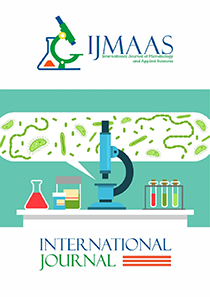Microbiological Characteristics of Crude Petroleum Polluted Farmland Soils of Nweol Community in Rivers State, Nigeria
Vol. 4, Issue 1, 2025
KEYWORDS
Crude Petroleum, Farmlands, Soil Pollution, Hydrocarbon Utilizing Bacteria, Fungi, Population.
Abstract
Microbiological characteristics of Crude Petroleum polluted farmland soils in Nweol community of Rivers State, Nigeria were conducted to evaluate the effect of crude Petroleum on microbial populations and types. Standard microbiological procedures were employed during the experiments. Soil samples were collected from crude oil polluted sites, and unpolluted samples served as control. Ranges of mean values of total heterotrophic bacteria count (THB), total fungi (TF), hydrocarbon utilizing bacteria (HUB) and hydrocarbon utilizing fungi (HUF) in the polluted soils in: Baraol-Chara 1:THB between 1.17×106 and 1.36×106CFU/g, TF 0.83×106 and 0.96×106CFU/g, while HUB 0.51×104 and 1.76×104CFU/g, HUF 0.34×104 and 0.38×104CFU/g. Percentage mean HUB 28.41%, Percentage mean HUF 21.99%. Baraol-Chara 2: THB between 1.56×106 and 1.98×106CFU/g, TF 0.59×106 and 0.73×106CFU/g. While HUB ranged between 0.36×104 and 0.63×104CFU/g, HUF 0.31×104 and 0.46×104CFU/g with Percentage mean of 22.56% and 25.73% respectively. Baraol-Gor: THB between 1.23×106 and 1.45×106CFU/g, TF 0.43×106 and 0.63×106CFU/g. While HUB ranged between 0.35×104 and 0.53×104CFU/g, HUF 0.23×104 and 0.43×104CFU/g with Percentage mean of 17.27% and 35.27% respectively. The unpolluted Gava Area/control: THBC ranged between 0.43×106 and 0.92×106CFU/g, TF 0.24×106 and 0.33×106CFU/g, while HUB ranged between 0.23×104 and 0.28×104CFU/g, HUF 0.11×104 and 0.17×104CFU/g with Percentage mean of 31.76% and 17.01% respectively. Bacterial isolates were; Staphylococcus aureus, Micrococcus roseus, Serratia marcescens, Pseudomonas aeruginosa, Pseudomonas fluorescens, Chromobacterium violaceum, Escherichia coli, Bacillus subtilis. Fungal isolates were; Aspergillus niger, Penicillium frequentans, Trichoderma viridae, Aspergillus nidulans, Fusarium moniliforme, Aspergillus terreus. The very high indices for the Petroleum hydrocarbon utilizing bacteria and fungi recorded in this study is an indication for the lingering presence of Petroleum pollutants in the farmlands, and a remarkable evidence for health risk of crops grown in the farms to unsuspecting consumers.
Current: Vol. 4, Issue 1, 2025

Call for papers
The International Journal of Microbiology and Applied Sciences warmly welcome your valuable articles for publication.
